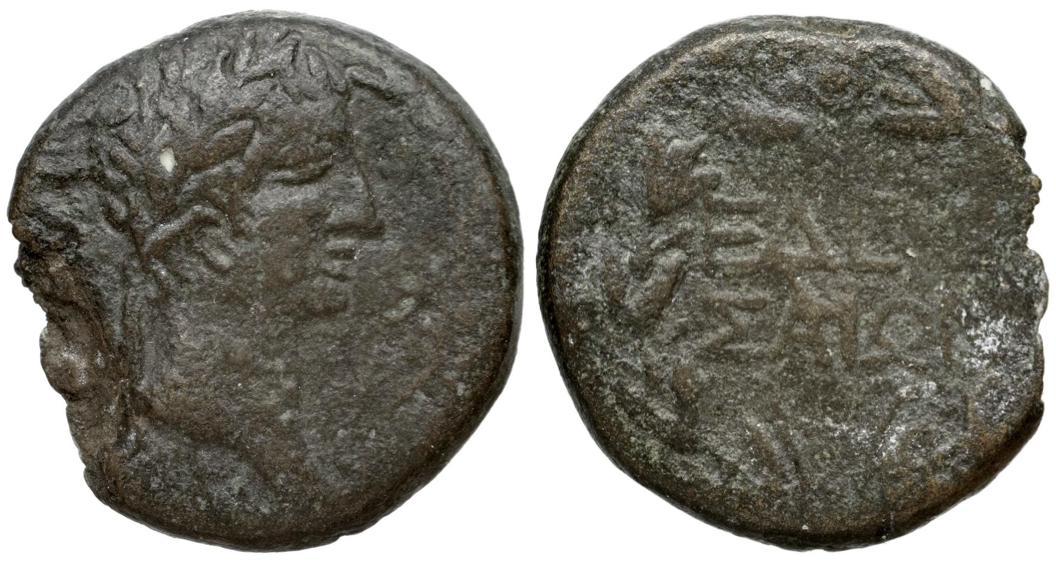RQEM ad. 11 - Edessa (Macedon) (Augustus), bronze, asses (27 BCE-14 CE)
From SILVER
27 BCE - 14 CE Bronze
Description
| ObverseInscription or printing placed on the obverse.: | Καίσαρ Σεβαστός (Greek).Head of Augustus right, wearing laurel wreath. Border of dots. |
| ReverseInscription or printing placed on the reverse.: | ᾽Εδεσσαίων (Greek).Ethnic within berries and laurel wreath. Border of dots. |
Mint and issuing power
| MintIdentifies the place of manufacture or issue of a numismatic object.: | Edessa | Ancient regionAncient region.: | Macedon | Modern countryModern country: Greece | AuthorityIdentifies the issuing power. The authority can be "pretended" when the name or the portrait of X is on the coin but he/she was not the issuing power. It can also be "uncertain" when there is no mention of X on the coin but he/she was the issuing power according to the historical sources: | Augustus (Roman emperor, 27 BC-14 AD), Roman Empire |
Chronology
| FromIdentifies the initial date in a range assigned in a numismatic context. | 27 BCE | toIdentifies the final date in a range assigned in a numismatic context.. | 14 CE | PeriodTime period of the numismatic object.: Roman from 30 BC |
Physical description
| MetalThe physical material (usually metal) from which an object is made.: | Bronze |
Median weightMedian of the weights of numismatic objects (in grams). in grams | 8.50 | DenominationTerm indicating the value of a numismatic object. Examples: tetradrachm, chalkous, denarius.: | as |
StandardStandard.: |
Image

RQEM_ad_11.png "Paris, BnF, 1982.116 (https" has not been listed as valid URI scheme.[Paris, BnF, 1982.116 (https://gallica.bnf.fr/ark:/12148/btv1b8590443x)]
References
| Die study referencePublication of the study: | Papaefthymiou 20021Papaefthymiou 2002, p. 39-42, no. 2-25. | ||
| Coin series referenceReference to coin series study: | |||
| Coin series web referenceCoin series web references: | |||
Obverse dies distribution
| FrequencyFrequency of specimen in distribution. ᵖ | Number of obversesNumber of obverse dies. ᵖ (o) | % (o) | Number of coinsNumber of coins. (n) | % (n) | Die nameName(s) of the die(s). |
| 1 | 4 | 36.36 | 4 | 9.76 | 3, 5, 11, 12 |
| 3 | 2 | 18.18 | 6 | 14.63 | 4, 9 |
| 4 | 3 | 27.27 | 12 | 29.27 | 6, 7, 8 |
| 5 | 1 | 9.09 | 5 | 12.2 | 2 |
| 14 | 1 | 9.09 | 14 | 34.15 | 10 |
| Total | 11 of 11 | 99.99 | 41 of 41 | 100.01 |
Reverse dies distribution
no distribution is available
Quantification
| Number of obversesNumber of obverse dies. ᵖ (o) | 11 | Number of singletons (o1)The number of singleton coins. ᵖ | 4 |
| Number of reverse diesNumber of reverse dies. (r) | 20 | Number of coinsNumber of coins. (n) | 41 |
| Coins per obverse dieNumber of coins per obverse die. (n/o) | 3.73 | Coins per reverse dieNumber of coins per reverse die. (n/r) | 2.05 |
| Reverse per obverse ratioRatio of obverse dies divided by reverse dies. (r/o) | 1.82 | Percentage of singletons (o1)number of coins (n) divided by the number of singletons (o1) ᵖ | 36.36 % |
| Original number of dies (O) (Carter 1983 formula)The estimation of the number of coins according to Carter 1983 ᵖ | 13.05 | Coins struck if 20,000 as average productivity per dieCoins made if the average productivity for obverses (according to Carter) is 20,000. ᵖ | 261,000 |
| Original number of dies (O) (Esty 2011 formula)The estimation of the number of coins according to the singleton formula in Esty 2011 ᵖ (O) | 15.03 | Survival rate if 20,000 as average productivity per dieSurvival rate if average productivity is 20,000. ᵖ | 0.00016 |
| Coverage (o = % of O) (Esty 1984 formula)Esty 1984 - coverage (% of O) ᵖ (o = % of O) | 90.24% | Die productivity if survival rate 1/2,000Average productivity if survival rate is 1/2,000. ᵖ | 6,283.52 |
| Weight of silver (in kg) if 20,000 coins per die (O = Carter formula)Carter 1983 * Median weight * 20000 (*10 if gold or electrum) ᵖ | n.a. | Die productivity if survival rate 1/5,000Average productivity if survival rate is 1/5,000. ᵖ | 15,708.81 |
Remarks
The coinage of Augustus is divided in 2 groups and 3 issues: the as correspond to group B divided in issues 2 and 3. The 2nd issue is dated 16 BC-14 AD and the 3rd is not dated. In the denominations table, p. 196, it is written that there is a double assarion (8,37 g, 25 mm) for Augustus. It is perhaps the coin no. 4 in the catalogue which is described as the same denomination than the others p. 40 because of the diameter of the border of dots: here, it is with the as. Metrology p. 189-209.